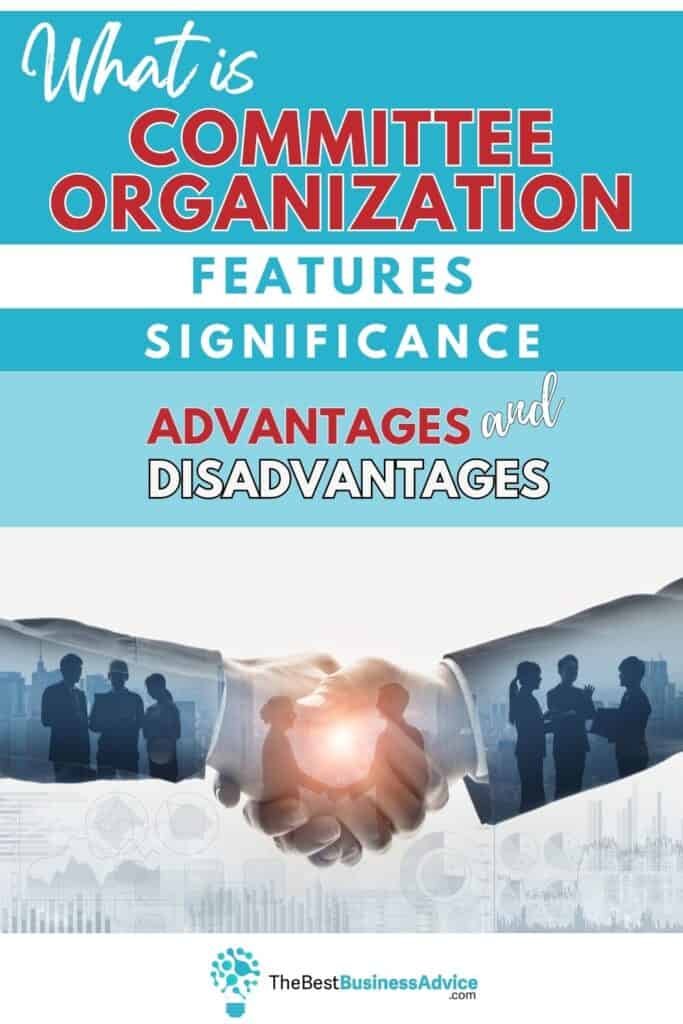What Is Committee Organization: Features, Significance, Advantages, And Disadvantages

A committee organization is the core foundation of any solid business venture. It fosters collaboration between various divisions, aids efficiencies, and addresses mission-critical business matters to ensure financial sustainability.
Thus, it is imperative to understand a committee organization’s core features and structure, including its advantages and disadvantages, to establish an efficient committee.
Table of Contents
Committee Organization Definition
A committee organization is defined as a group of individuals formally mandated by senior management to review and solve operational matters and to make prudent business decisions on the way forward.
Committees predominantly consist of members with a wide range of expertise to collate, analyze information, and devise problem-solving business ideas and strategies.
These committee organizations are essential to alleviate the workload of executive-level managers to address critical operational matters.
A committee organization is typically bound by formal regulations or procedures. It may or may not require a completed quorum or that all the members be present when the committee convenes a meeting.

Features Of Committee Organization
Even though committee organizations may differ in certain aspects, they all share certain features or traits and perform different functions.
So, without further ado, here are the main characteristics of a formal (executive) and informal (ad-hoc) committee meeting.
The Core Features Of A Committee Organization

All committee organizations have four core components: governance, tabling, research, and recommendations, including coordination.
Good governance requires structures like committees to foster accountability and transparency within organizations.
Therefore, committee organizations must review certain matters like budgets, product development, or business strategies, and then coordinate resources to execute their decisions.
The two main types of committee meetings are as follows:
- Formal/standing/executive committees are comprised of employees who are formally appointed or elected as board members and are required to review specific matters. These committee members have the authority to operationalize their committee’s decisions.
- Informal/temporary committees are typically formed on an ad-hoc basis when a manager or a CEO requires the expertise of department heads to make recommendations concerning unforeseen operational matters.
The primary difference between formal (executive) and informal ad-hoc committees is their respective levels of authority.
Formal committee meetings are typically high-level or board of directors’ level meetings, where members have the authority to oversee succession planning, devise business strategies, and approve operational, including compensation budgets.
In stark contrast, informal committee meetings may only make recommendations and do not have the authority to operationalize their findings. An informal committee meeting’s decisions may or may not be executed.

Structures Of Committee Organization
Even though the roles, responsibilities, and permanence of committees vary, they are predominantly structured in the following way.
Standard Committee Meeting Structures

Most formal and non-formal committees comprise a chairperson (president), vice chair, secretary, and treasurer, performing pre-defined duties within a committee meeting.
Formal or executive board of directors committees with more than seven members may have numerous sub-committees that report to the board.
The chair and vice chairperson of the board do more than merely provide leadership, as they are also tasked with devising work plans, including committee meeting agendas.
Organizations may also convene executive committee meetings that have the authority to meet in between board meetings. They serve as a liaison between a company’s CEO and its board and may act as the CEO’s advisor.
Audit committees typically comprise 3-5 members who meet on a seasonal basis to review a company’s annual financial statement before it is submitted to the board of directors and approved.
On the other hand, governance committees ensure that the board complies with laws and regulations and oversees the recruitment of board directors, the orientation of newly elected directors, and their professional development.
Finance, or “budget and finance committees,” oversee and review a company’s annual budget, revenue, and expenses. This committee typically comprises the CFO and senior or executive level employees.

Why Building A Committee Organization Is Important?
Establishing committee organizations is essential as they provide a unifying platform for problem-solving, exchanging ideas, and fostering innovation.
Committees are the cornerstone of good governance. They provide a solid structure and a forum for developing an organization’s policies and procedures.
Most importantly, committee organizations harness the diverse skills, experience, and in-depth knowledge that every member brings to the table to create a financially sustainable venture.

Committee Organization Advantages And Disadvantages
Even though committees play a vital role in every organization, it is essential to note that while they are advantages, there are some potential disadvantages associated with dysfunctional committees that need to be taken into consideration.
Especially because committee organizations are prone to specific issues that can negatively affect business operations. Here are the main advantages and disadvantages:
Advantages
The main advantages of establishing a committee organization are as follows:
- Balanced Views
Different perspectives from various organizational divisions, with diverse backgrounds and skills, aid problem-solving as everyone’s divergent opinions must be considered.
Therefore, everyone’s input is used to make prudent decisions that are realistic and well-informed.
- Improved Communication
Committees are an ideal platform to discuss problematic matters, as they aid communication between the members and their subordinates, who would otherwise be more biased and not engage with each other.
- Greater Coordination
Divisions within an organization tend to work in silos, to the detriment of a business venture. Thus, a committee unites representatives from various departments, who are forced to sit around a table to iron out their differences, devise solutions, and improve coordination between the different business units.
- More Motivation
Committees typically consist of managers and their team members or subordinates.
Therefore, subordinates feel empowered and motivated when they are included in meetings. Their input is recognized and valued in a formal business setting, and they don’t feel disenfranchised.
- A Balance of Power
Due to the democratic nature of committee organizations, decision making powers are not concentrated on a few key employees who may abuse their level of authority.
In that sense, it empowers all levels of employees within an organization, as they all have the authority to make decisions.
- Greater Acceptance from Subordinates
Lower ranking employees are far more likely to accept a committee’s decisions that are comprised of a balanced mix of senior and junior level employees from diverse backgrounds.
Decisions made by autocratic leaders, however, are made without consulting other stakeholders.
- Senior Management Training
Committee organizations are the ideal platform to train future executives as they learn core leadership and problem-solving skills.
Most importantly, they learn how to interact with people from diverse backgrounds and how to efficiently address any conflict that may arise.

Disadvantages
Here is a brief overview of a committee organization’s potential disadvantages:
- Delayed Decisions
One of the most significant drawbacks of committee meetings is that they take a lot of time to reach a decision due to differing opinions, lengthy agendas, and an inability to find suitable meeting dates.
Committees are not always agile enough to make prompt decisions. These delayed decisions can result in lost potentially lucrative opportunities.
- Conflicting Views
Strained relations between committee members with opposing ideas or points of view can cause friction if one member does not agree with a particular decision.
The offended party may then leak the committee’s discussions with other employees negatively affected by the committee’s decision.
- Too Much Compromise
Most committees aspire to reach a consensus based on input from most of their members. However, those in the minority may feel obliged to accept the most popular decision, even though it may not be in the organization’s best interest.
Therefore, the inability to consider the opinions of those in the minority can jeopardize an organization and should be avoided.
- Committee Organisation Limitations
Committee organizations are ideal platforms for addressing grievances and day-to-day operational matters.
However, they are not agile enough to make urgent decisions about matters impacting a business. An authoritative individual is best suited to address mission-critical, unforeseen matters.
- Lack of Accountability
Because decisions are made as a group or collectively, individual members may not take responsibility or accountability for their input when a decision has disastrous consequences that jeopardize an organization’s financial sustainability.
And this lack of accountability for certain decisions has the potential to harm an organization irrevocably.
- Ultra-Dominant Committee Members
Certain committee members may attempt to dominate the meeting, and aggressively manipulate others to support their views.
Minority views are often overlooked at the organization’s expense, with potentially adverse consequences.
Wrap-Up
Whether formal or informal, committee organizations play a pivotal role in all ventures. They unite representatives from divergent business divisions with diverse skills and expertise to solve mission-critical operational matters.
Most importantly, committee organizations are a core governance component of all efficient organizations as they create a structure that fosters accountability, transparency, and innovation.
While there is no doubt that establishing a committee organization is advantageous, it is vital to also consider its potential disadvantage to avoid any pitfalls that can jeopardize a venture.
PIN THIS FOR LATER…
DID YOU FIND THIS INFORMATION HELPFUL? Share the love on social.
Follow us on Pinterest & Instagram!
ANY OTHER BUSINESS ADVICE WE CAN WRITE ABOUT?
Let us know, email us at: Advice@TheBestBusinessAdvice.com

![]()








